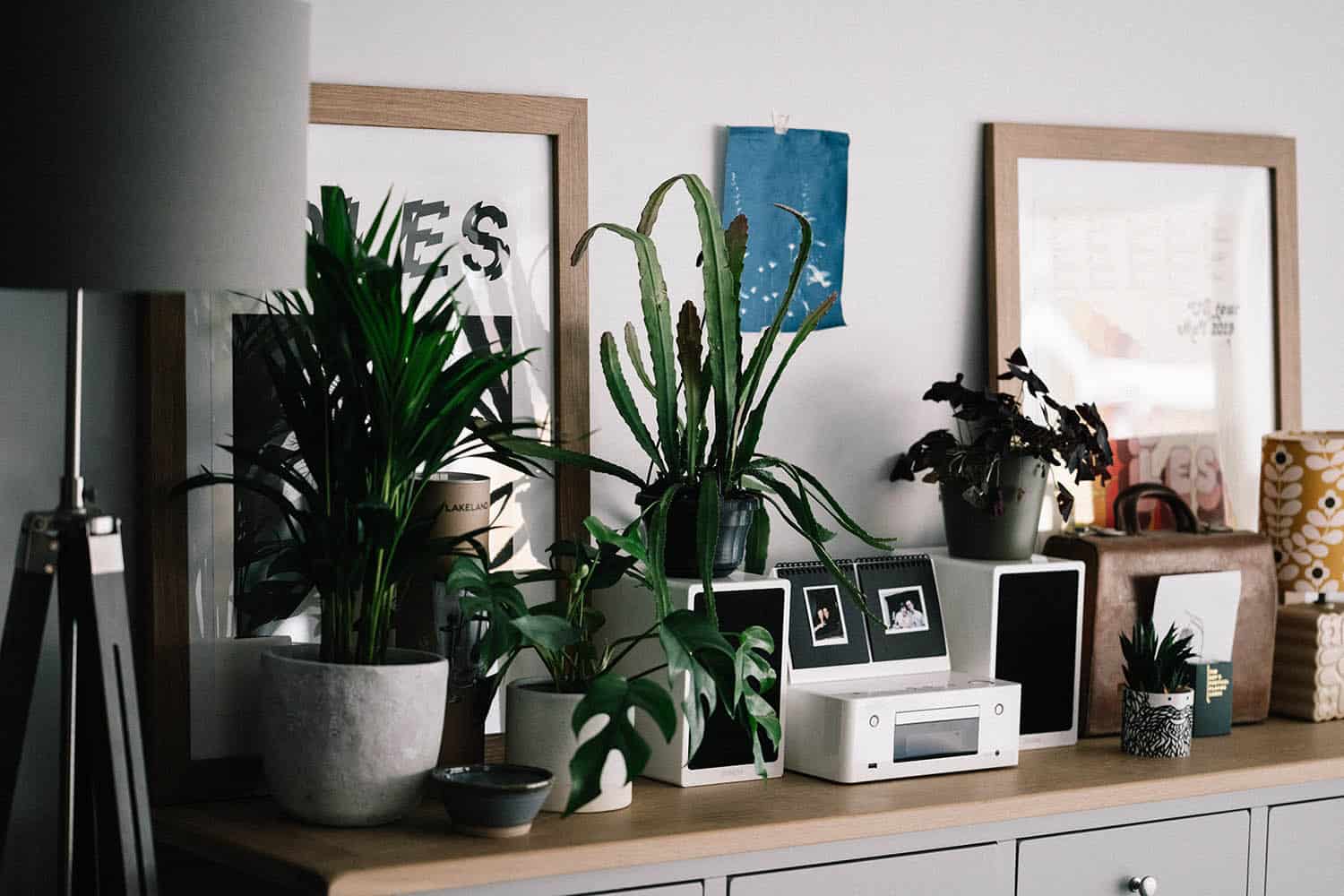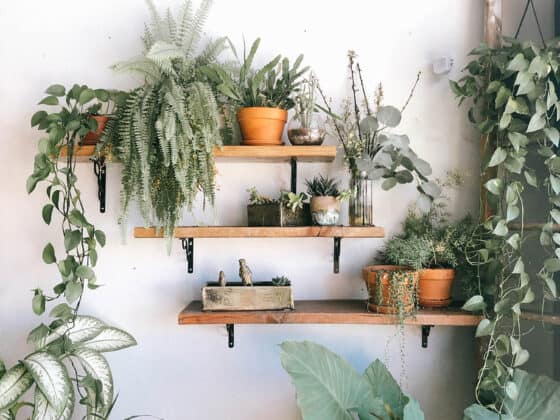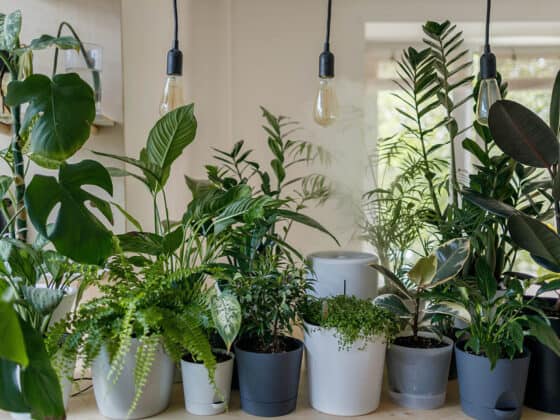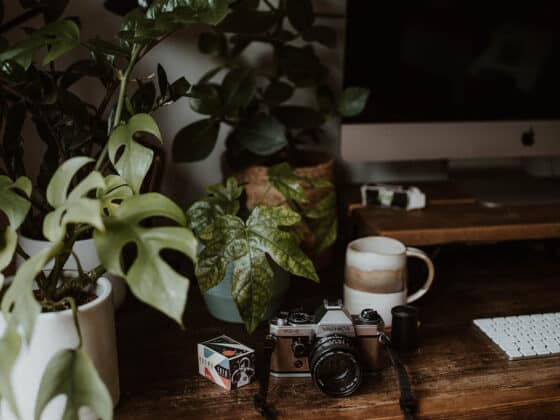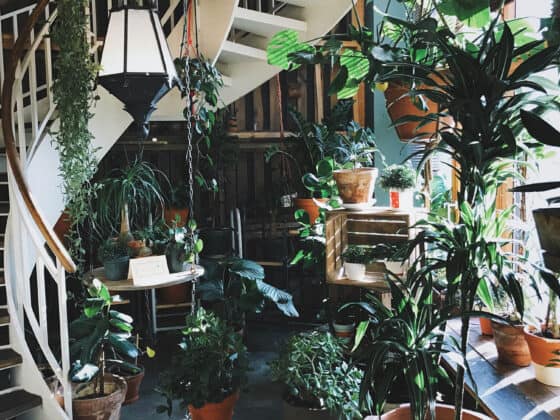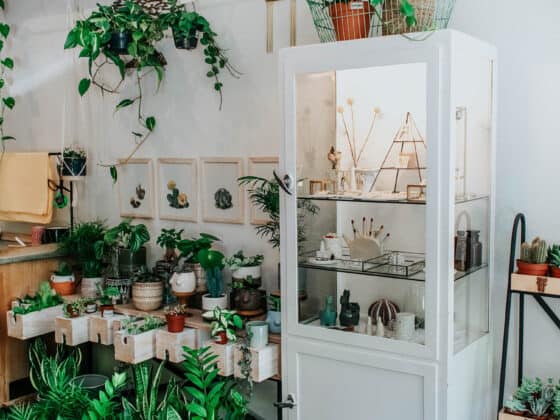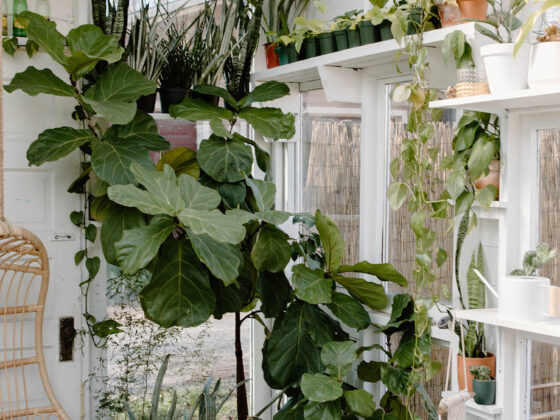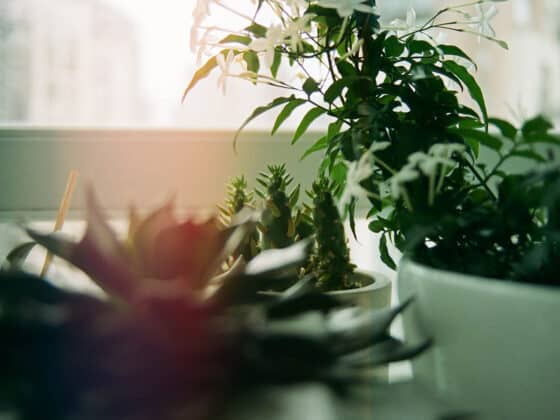If you’ve ever had to deal with a thrips infestation on one of your houseplants, you know how persistent they can be, even after several treatments. Perhaps because of this, many people want to know more about these insects. Are they damaging to your houseplants? Can they spread to other plants? And, how, exactly, did they get into your home?
Thrips are tiny, sap-sucking insects that often go unnoticed on a houseplant until signs of damage are visible. Because of their size, they are easily carried into the home through open doors or windows, on our clothes, or by hitching a ride on a pet’s furry coat. Once established, a thrips population can grow quickly.
Regardless of how they got into your home, you should act fast once you notice them on your houseplants. Luckily, there are plenty of different treatment options available to deal with a thrips infestation, but in order to decide which one works best for your plants, you should have an understanding of how these insects operate.
In this article, we’ll cover the most commonly asked questions about thrips, including how your houseplants get them, what kind of damage they can do, and most importantly, what you can do to get rid of them.
If you are already familiar with thrips and are just looking for treatment options, check out this article about the different methods you can use.
What are Thrips?
Thrips are a class of very small, winged insects that feed on the sap of both outdoor and indoor plants. Although they are more common outdoors, thrips can find their way into our homes and take up residency on even our most prized houseplants.
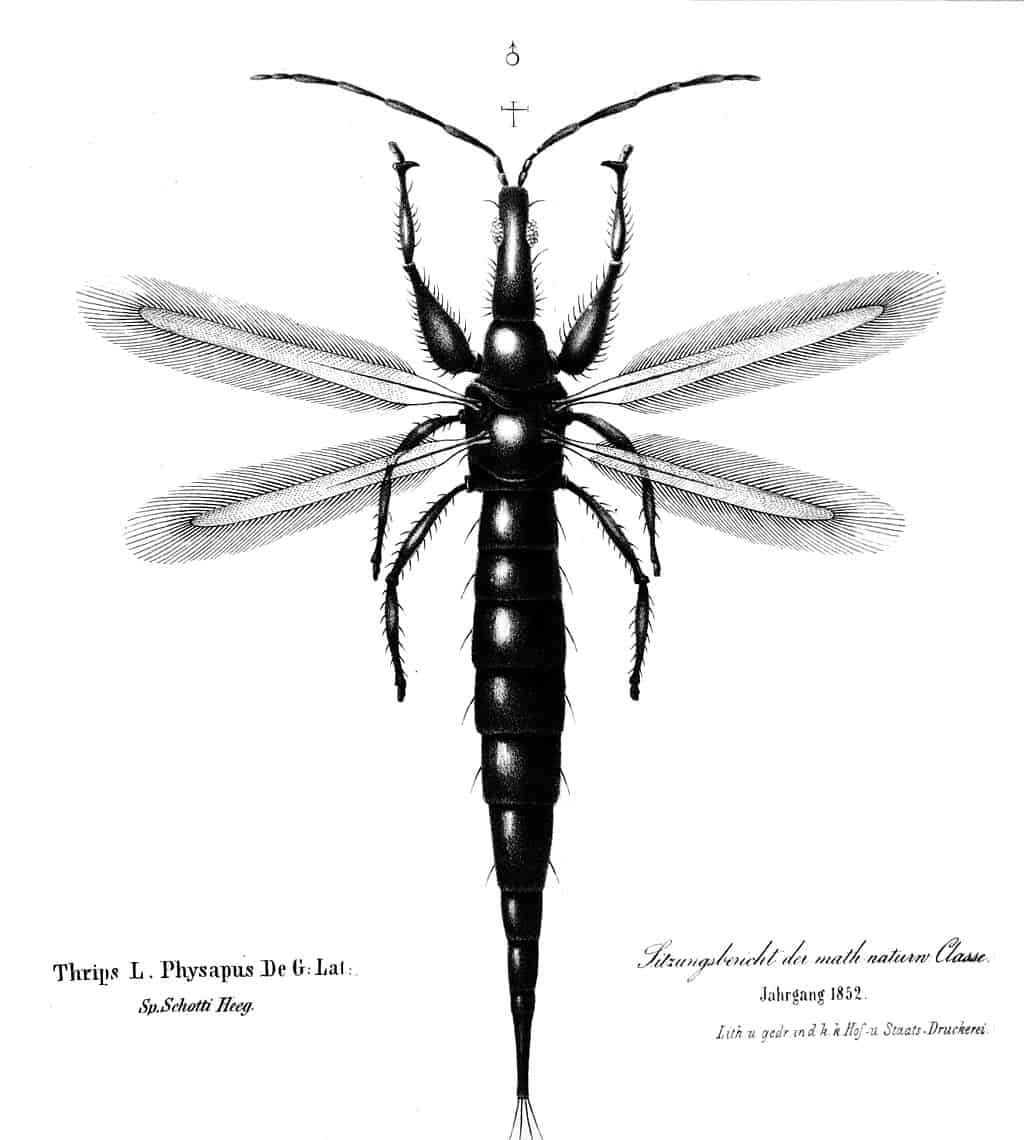
Thrips are piercing, sucking insects that will puncture plant tissue on leaves or stems to gain access to and feed on the sap that flows throughout a plant. Adults will lay eggs that hatch into tiny nymphs, which do the most damage to the plant. Because of their small size, it is often difficult to catch an infestation early, and you may only notice them once a plant begins to display signs of damage and distress.
What Color are Thrips?
Depending on the species of thrips you find on your houseplant, adults can range from translucent to white, green, yellow, brown, or black. You’ll likely see dark brown or black adults, as they are more commonly found on the types of plants we typically have indoors.
Nymphs can be translucent, white, pale yellow, or green, although they are usually so small that it’s hard to distinguish which color they actually are.
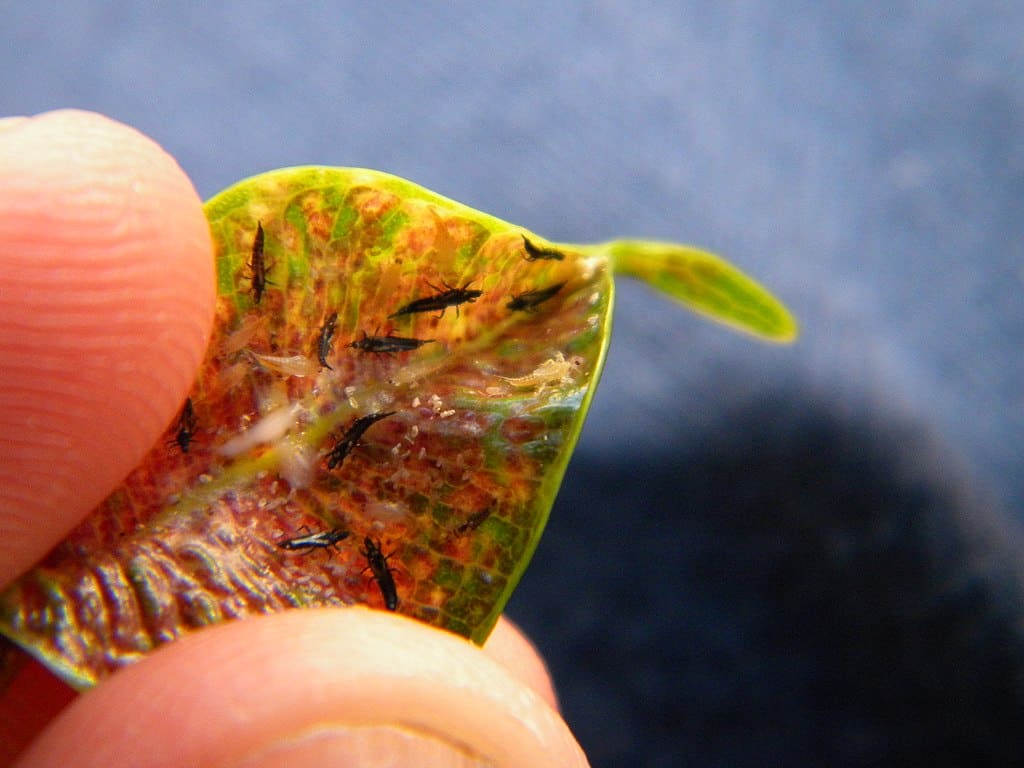
How Does a Houseplant Get Thrips?
In most cases, thrips are unknowingly carried into our homes. Although adults have wings, they are terribly weak fliers and won’t often make a journey more than a few feet away from where they originated.
However, because of their small size, they can be easily transported in a variety of different ways. Strong breezes can carry flying adults longer distances, right into open windows or doors. If you spend any time outside doing yard work or walking through a park, you can very easily carry thrips into your home on your clothes. The same goes for pets, especially those with thicker coats.
The most common way thrips enter the home is by being transported on another plant. Even though plant sellers try to be super diligent about their products being pest free, oftentimes, a small thrips infestation can go unnoticed, and we unwittingly introduce them into our homes. Alternatively, any plants we bring in from outdoors, be it a houseplant that you’re giving some extra sunlight to, or just a few cut flowers to put in a vase, can be vectors for introducing thrips.
This is why it is always a good idea to isolate any plants you bring indoors for a few days, just to make sure you don’t have any pesky stowaways that are waiting to infest other houseplants. After a few days on its own, a new plant can be integrated into your collection.
Can Thrips Live Indoors Without Plants?
Thrips use plants in a variety of different ways to keep their life cycle moving along. First and foremost, the sap is what they feed on exclusively, so having access to a plant that can provide them with their food source is imperative.
Second, a very small portion of a thrips’ lifecycle involves juvenile nymphs pupating in soil and emerging as new adults. Without some sort of organic matter for the pupae to live in, their life cycle is interrupted, causing the eventual collapse of a population.
Houseplants provide both of these requirements for thrips in an indoor environment. Without a plant, though, most indoor spaces won’t have an adequate food source or the right organic matter for thrips to survive for very long. This means you don’t have to worry about thrips thriving in indoor spaces apart from your houseplants.
Do Thrips Need Soil? Can They Live In LECA?
As mentioned above, a small part of a thrips’ lifecycle involves the juveniles pupating into adults in some kind of organic matter. In most outdoor settings, this means the nymphs drop from the plant into the soil below, where they become pupae and eventually transform into new adults, which fly back up onto the plant to lay eggs and start the cycle over again.
Indoors, this happens almost exclusively on a houseplant. Potting soil is often the only adequate organic matter available for thrips to pupate in, and therefore can be considered a requirement for thrips to survive indoors.
Because LECA is considered a sterile growing substrate, thrips populations can definitely be harder to sustain, since the lack of decaying organic matter can disrupt their life cycle. That being said, plants in LECA can still get infested by thrips.
Adults and nymphs can still do quite a bit of damage to the plant before a population is knocked back. Also, because females have been shown to be able to reproduce asexually, adults can continue laying eggs that will hatch into more plant-damaging nymphs, making it that much harder to kill off a population.
What Does Thrips Damage Look Like?
When it comes to thrips, the damage they cause to houseplants tends to be pretty recognizable and is often the first sign that you are dealing with an infestation.
Remember that these pests feed by piercing the plant’s tissue with their mandible, causing tiny pinprick holes across the surface of both leaves and stems. As the population grows in size, this destruction compounds as they continue to feed, causing visible damage.
You may begin to notice that your houseplant has begun to develop silvery streaks along its leaves or flowing parts. This is actually swaths of thrips damage. Leaves may begin to look dull, taking on a brownish or yellowing appearance. New growth may emerge stunted, contorted, or deformed.
If you see any of these symptoms on your houseplant, but don’t see any visible pests, take a very close look at your plant, especially the underside of leaves to see if you can identify the tiny thrips nymphs crawling across the surface. A magnifying glass may help with this task.
Do Thrips Kill Houseplants?
The damage thrips inflict on houseplants can be considered pretty mild, at least in the early stages of an infestation. Because of their tiny size, thrips can’t do too much damage on their own. However, as the population begins to grow, all of that damage adds up, and you may find yourself with a houseplant that is suffering quite a bit.
Over time, without any kind of treatment, thrips can eventually kill off a houseplant. It takes a long time for it to happen, and your plant will look terrible long before it kicks the bucket, but the physical damage to the plant tissue, the diminished ability to photosynthesize and transport nutrients, and the lack of healthy new growth will all contribute to the plant’s demise.
In addition, the sooty black fecal matter thrips produce can also be a vector for diseases that may kill a houseplant.
Are Thrips Harmful to Humans?
Although they can do a number on a houseplant, thrips pose no threat to humans. We can’t provide these insects with any sustenance or the right environment to reproduce, so they are useless to them. Even if they wanted to bite us, they are too small and lack the anatomy to pierce our skin.
Other than the ick factor and their ability to damage our beloved houseplants, thrips can’t harm humans in any way.
Where Do Thrips Lay Eggs?
Adult female thrips have the important job of laying eggs that will hatch into the next round of nymphs that will feed on the plant’s sap for the next 7-10 days. What’s important to know is that the females will actually create small gashes in the plant’s tissue and lay their eggs up inside these slits, where they remain protected until they hatch.
This is one reason thrips are such persistent pests. You may kill off a lot of adults and nymphs with a foliar spray, but because those eggs tend to be buried within the plant, they often are spared from a treatment application and will hatch out a new generation of nymphs within a matter of a few days.
Do Thrips Hop or Fly?
Adult thrips are winged insects that have the ability to move rather quickly. Although they aren’t the strongest fliers, they can crawl quickly, leap or hop, and fly short distances when they are disturbed.
They mainly move by crawling along plants or soil but will fly when necessary, like when they emerge from the soil and need to get back up to a plant.
Can Thrips Spread to Other Plants?
Although thrips aren’t the best fliers, they can still be easily spread to other houseplants in your home. Thrips tend to stick close to an infested plant for some time, especially when their food source is readily available. However, as the population grows and the health of the plant becomes compromised, thrips will begin to seek out new plants to support their population.
We’ve already mentioned that thrips can crawl, hop, or fly short distances when disturbed, so it makes sense that they’d be able to seek out another houseplant that has been placed nearby. Also, remember that because they are small, they can be easily transferred between plants by hitching rides on our clothing.
Keep that in mind the next time you are watering or pruning your houseplants.
Will Thrips Go Away on Their Own?
Once you find a thrips infestation inside your home, it is best to act quickly and deploy a series of treatment options to get them under control. This is because thrips are tenacious creatures that will not go away alone.
Because of how they feed and reproduce, one houseplant can survive quite a long time, supporting an exploding population of thrips. Eventually, the plant’s health will collapse, and it may die, and without another houseplant to move to, the thrips population will also be killed off.
However, before that scenario plays out, there is ample time for thrips to be spread throughout your home, potentially onto several other plants. Rather than waiting to see if an infestation remains isolated on one plant, be proactive by quarantining and treating it quickly, with the goal of eliminating the entire thrips population.
Can Thrips Survive in Water?
Thrips are not water-based insects by any means. They require a plant as a food source and organic matter to complete all stages of their life cycle. Unlike mosquitos, thrips don’t have any portion of their life cycle that is carried out in water.
In fact, thrips will drown after several minutes of being submerged in water. However, I don’t typically recommend submersion as a treatment option, mainly because it can cause more stress to the plant you are trying to save.
Strong surges of water are a great way to blast a good portion of a thrips infestation off your plant, but be sure to follow it up with either some kind of foliar spray or drench to treat all stages of the life cycle. Also, skip this if you are dealing with a delicate plant. Strong blasts of water can tear up a fragile plant pretty easily.
How Do You Treat for Thrips?
When dealing with a thrips infestation, it is always best to act quickly. While you can take many different approaches to treat for thrips, here are a few tips that can help you implement a plan that works for you.
First and foremost, quarantine your infested plant away from the rest of your collection. You want to avoid thrips from spreading throughout your home, so pick a place far away from anything they might want to colonize.
Also, choose a spot with cooler temperatures and higher humidity. Thrips tend to thrive in warm, dry climates, so by increasing the humidity levels and dropping the temperature slightly, you can slow their reproduction down.
As mentioned above, a quick rinse under a strong tap or from a hose can initially knock a lot of thrips off the plant, effectively reducing the population. Again, only do this if your plant is hearty enough to handle it.
At this point, you should consider treatment options. We prefer to pick methods that target all parts of the life cycle for faster control; using a foliar spray with soapy water, neem oil, or something similar, you can drench the soil with hydrogen peroxide or diatomaceous earth to target the pupae, as well.
If you want to use one treatment method only, be prepared to apply it every few days. For example, a neem oil spray will target adults and nymphs easily, but eggs and pupae are often protected and will produce more thrips within a matter of days. By repeating subsequent spray applications every few days, you can target any newly emerged thrips.
There are many treatment options for thrips, most of which are low-impact and safe to apply inside your home. If you want a deeper dive into how these different methods work, take a look over the tips we’ve included here.
Final Thoughts
Hopefully, after reading this article, you better understand what thrips are, how they reproduce and spread, and steps you can take to treat for them.
Although they can be persistent, your new knowledge of thrips should equip you to identify an infestation quickly and deploy the right types of treatments so they don’t have time to do any significant damage to your plants.
With a little practice and a good amount of vigilance, we’re confident you can nip any future thrips infestations in the bud!






